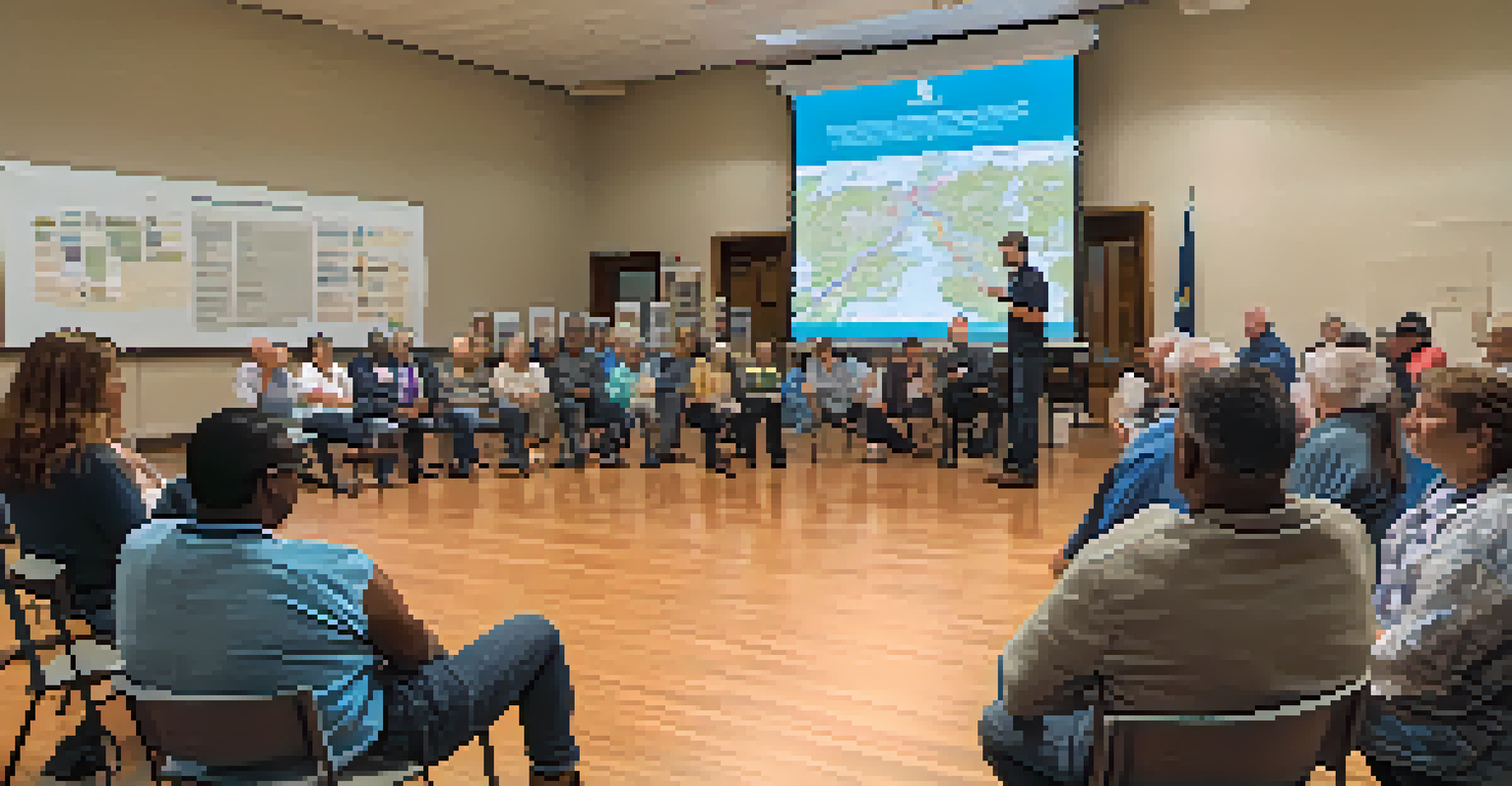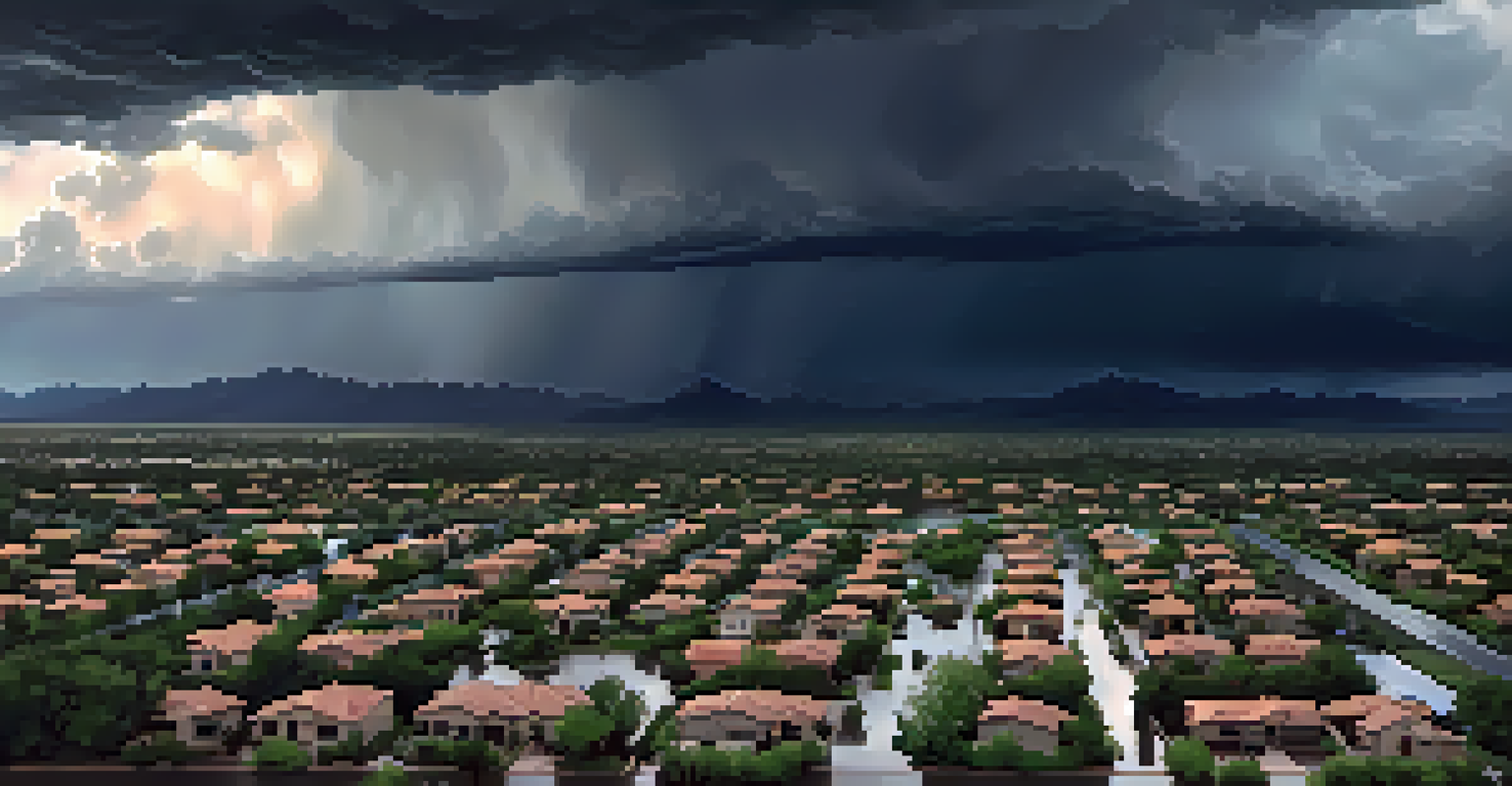Educating the Public on Flood Risks in Arizona Communities

The Importance of Flood Awareness in Arizona Communities
Flooding is often seen as a distant threat, but in Arizona, it's a reality that can impact many residents. With monsoon season bringing heavy rains, communities need to understand the risks they face. Increased awareness can lead to better preparedness, ultimately saving lives and property.
Preparedness is the key to resilience in the face of natural disasters.
Educating the public about flood risks is essential, especially in areas prone to sudden storms. Knowledge empowers residents to take necessary precautions, such as creating emergency plans and understanding evacuation routes. By fostering a culture of awareness, communities can minimize the impact of floods when they occur.
Moreover, when local authorities and agencies collaborate with residents, the message becomes stronger and more effective. Engaging the community through workshops, brochures, and social media campaigns can enhance understanding and participation in flood risk management efforts.
Understanding Flood Zones: What Residents Should Know
Flood zones are designated areas that indicate the likelihood of flooding based on historical data. In Arizona, they can vary significantly, with some neighborhoods more at risk than others. Knowing your flood zone is the first step in understanding your personal risk and taking appropriate action.

Residents can check flood maps provided by local agencies to see if their homes are in a high-risk area. This information is vital for making informed decisions about flood insurance and property improvements. For example, a home in a high-risk zone might benefit from elevation adjustments or flood-proofing measures.
Flood Awareness Saves Lives
Increased awareness of flooding risks empowers Arizona communities to prepare effectively, ultimately saving lives and property.
By understanding flood zones, residents can also participate in community planning efforts. Advocating for infrastructure improvements or better drainage systems can help mitigate flood risks for everyone, fostering a sense of shared responsibility.
Creating an Emergency Plan for Flood Situations
An emergency plan is crucial for any household, especially in flood-prone areas. Families should sit down together to discuss potential flood scenarios and outline steps to take if a flood warning is issued. This could include creating a communication plan to ensure everyone knows where to go and what to do.
In the end, it’s not the years in your life that count. It’s the life in your years.
Having an emergency kit ready is also essential. This kit should include items like water, non-perishable food, flashlights, and first-aid supplies. By preparing in advance, families can reduce panic and confusion during an emergency, making it easier to respond quickly.
Additionally, consider designating a safe meeting place away from your home. This way, if evacuation is necessary, everyone knows where to regroup. Planning together fosters unity and readiness, empowering families to face flood risks head-on.
The Role of Local Agencies in Flood Education
Local agencies play a pivotal role in educating residents about flood risks. They provide resources, information, and support to help communities prepare for potential flooding. By hosting workshops and community meetings, these agencies can disseminate vital information effectively.
Additionally, local authorities often collaborate with schools and organizations to reach younger audiences. Teaching children about flood risks and safety measures ensures that the message is passed down to future generations. This proactive approach can lead to a more informed community overall.
Know Your Flood Zone
Understanding flood zones helps residents make informed decisions about insurance and necessary property adjustments.
Moreover, agencies use technology to spread awareness, such as social media campaigns and mobile alerts. These platforms allow for real-time updates and information sharing, keeping residents informed about weather conditions and potential evacuations.
Utilizing Technology for Flood Risk Awareness
In today's digital age, technology plays a crucial role in flood risk awareness. Apps and websites provide real-time weather updates, flood alerts, and safety information to residents. This accessibility ensures that individuals are well-informed and can act quickly in emergencies.
Social media is another powerful tool for spreading awareness. Local agencies can share important updates, safety tips, and community resources to a wide audience instantly. By engaging with residents through these platforms, agencies can foster a sense of community and encourage proactive measures.
Additionally, technology can help residents better prepare for floods by providing resources for creating emergency plans and kits. Online guides and checklists can simplify the preparation process, ensuring that everyone knows what to do when a flood threatens their community.
Community Involvement: Building a Resilient Network
Community involvement is key to building resilience against flood risks. When residents come together to discuss concerns and share resources, they create a stronger support network. This sense of community fosters collaboration and encourages individuals to take action for their safety.
Organizing local events, like clean-up days or flood preparedness workshops, can engage residents while promoting awareness. These activities not only educate but also strengthen community bonds, making it easier for neighbors to work together during emergencies.
Community Engagement is Key
Active community involvement fosters resilience by encouraging collaboration and resource sharing among residents.
Furthermore, empowering residents to lead initiatives can inspire others to participate. Local leaders can facilitate discussions and share their experiences, encouraging a culture of preparedness and resilience. Together, communities can create a safer environment for all.
The Future of Flood Risk Education in Arizona
Looking ahead, the future of flood risk education in Arizona lies in continuous improvement and innovation. As climate patterns change, communities must adapt their strategies to address evolving risks. This means staying informed about new technologies and leveraging them to enhance public education efforts.
Collaboration between local agencies, schools, and community organizations will be crucial in developing effective education programs. By pooling resources and expertise, these groups can create comprehensive initiatives that reach a wider audience. The goal is to ensure that all residents are prepared for potential flooding.

Ultimately, fostering a culture of awareness and preparedness will lead to more resilient communities. By prioritizing education and collaboration, Arizona can better protect its residents from the impacts of flooding, ensuring a safer future for all.